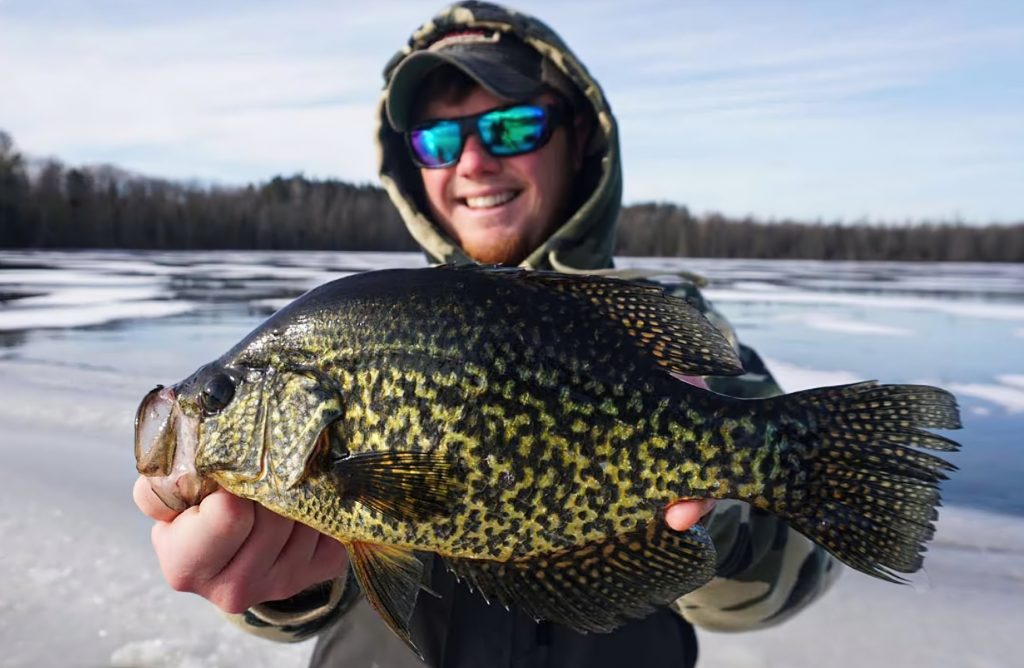Discover the importance of winter ice fishing for crappie and delve into the thrill and challenge of landing these coveted slabs on ice. Gain valuable insights into crappie behavior during winter and learn about essential gear, effective techniques, prime locations, and conservation practices. This comprehensive guide is tailored to professional anglers, providing real-life examples and practical tips for a successful winter ice fishing experience.
Importance of Winter Ice Fishing for Crappie
Winter is a prime time for crappie fishing, and ice fishing provides a unique opportunity to target these prized slabs. The colder temperatures and frozen lakes concentrate crappie in specific areas, making them more accessible to anglers. The thrill of battling a hard-fighting crappie beneath the ice adds to the allure of winter fishing. Catching a trophy-sized crappie through the ice is a rewarding achievement that tests an angler’s skills and patience.
Understanding Crappie Behavior in Winter
During winter, crappie undergo seasonal movements and adapt their feeding habits. Understanding their migration patterns and preferences is crucial for a successful ice fishing expedition. Factors such as water temperature, dissolved oxygen levels, and available food sources influence their activity and choice of habitats. By gaining insights into crappie behavior in winter, anglers can effectively target these fish and increase their chances of success.
Essential Gear and Equipment
To excel in winter ice fishing for crappie, selecting the right gear is essential. Ice fishing rods, reels, lines, and tip-ups should be chosen based on their sensitivity, strength, and suitability for the target species. Additionally, a well-stocked tackle box with a variety of lures, jigs, and bait is crucial for enticing crappie to bite. Understanding the characteristics and preferences of crappie will help anglers select the most effective gear and increase their chances of landing slabs.
Techniques for Catching Winter Crappie
Jigging is a popular and effective technique for catching crappie through the ice. Anglers can experiment with different jigging cadences, depths, and lure colors to trigger strikes. Deadstick and tip-up strategies are effective for targeting passive crappie, where the bait is suspended motionless beneath the ice. Additionally, utilizing electronics such as fish finders and underwater cameras can help locate and target active crappie schools, increasing the chances of a successful catch.
Prime Locations for Winter Crappie Fishing
Identifying productive areas is crucial for a successful winter crappie fishing expedition. Submerged structures such as fallen trees, brush piles, and rock formations often attract crappie, providing cover and food sources. Weed beds and drop-offs can also be prime locations to target crappie. Understanding the impact of water depth, clarity, and temperature on crappie movements will guide anglers to the most productive spots. Additionally, considering the influence of currents and underwater topography will further enhance the chances of success.
Case Studies: Successful Winter Crappie Angling
Real-life examples of professional anglers targeting crappie on ice provide valuable insights into their preferred techniques, gear, and locations. These case studies shed light on the specific strategies that have led to their success. By examining these examples, anglers can gain practical knowledge and apply it to their own fishing endeavors. Detailed information on location, time of day, and specific techniques used can guide anglers in their pursuit of trophy crappie.
Conservation and Ethical Considerations
Responsible catch-and-release practices are essential for the long-term sustainability of crappie populations. Anglers should handle crappie with care, minimizing stress and ensuring their survival upon release. Environmental awareness and good ice fishing ethics should be practiced to minimize the impact on the ecosystem. By adopting conservation practices and promoting sustainable fishing, anglers can contribute to the preservation of crappie populations for future generations.
Conclusion
Winter ice fishing for crappie offers a thrilling and rewarding experience for professional anglers. By understanding crappie behavior, utilizing the right gear and techniques, and identifying prime fishing locations, anglers can increase their chances of success in landing slabs on ice. The importance of selecting appropriate gear, including ice fishing rods, reels, lines, and tip-ups, cannot be overstated. A well-stocked tackle box with a variety of lures, jigs, and bait is also crucial for enticing crappie to bite.
Effective techniques such as jigging, deadstick fishing, and using electronics to locate active fish can significantly improve the catch rate. Anglers can experiment with different jigging cadences, depths, and lure colors to find what works best for crappie during the winter months. Employing deadstick and tip-up strategies can help target passive crappie by presenting bait in a motionless manner. Utilizing fish finders and underwater cameras can aid in locating schools of active crappie, increasing the chances of a successful catch.
Prime locations for winter crappie fishing often include submerged structures, such as fallen trees, brush piles, and rock formations, which provide cover and attract baitfish. Weed beds and drop-offs can also be productive areas to target crappie. Factors like water depth, clarity, temperature, and the presence of currents should be considered when choosing fishing spots.
Real-life case studies from professional anglers provide valuable insights into successful winter crappie fishing. By examining their techniques, gear choices, and preferred locations, anglers can adapt and apply these strategies to their own fishing endeavors.
Conservation and ethical considerations play a vital role in winter crappie fishing. Responsible catch-and-release practices ensure the preservation of crappie populations for future generations. Handling crappie with care and promoting environmental awareness are essential for maintaining a sustainable fishery.
In conclusion, mastering winter ice fishing for crappie requires an understanding of their behavior, the right gear and techniques, and knowledge of prime fishing locations. By applying the tips and strategies outlined in this article, professional anglers can increase their success rate and enjoy a thrilling and rewarding winter fishing experience. Embracing conservation practices and promoting ethical fishing contribute to the long-term sustainability of crappie populations and the preservation of this exciting sport for generations to come.

